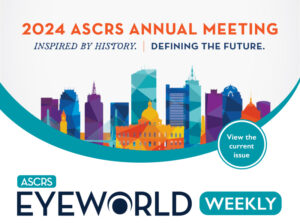
- Study: low-dose atropine doesn’t slow myopia progression
- Adverse events reported after use of FDA-approved geographic atrophy drug
- Phase 1 data for synthetic cannabinoid being investigated for glaucoma
- Enrollment complete in study evaluating topical diabetic retinopathy therapy
- Enrollment update for Phase 2b trial that could reduce AMD treatment burden
- ASCRS news and events
July 21, 2023 • Volume 29, Number 29
Study: low-dose atropine doesn’t slow myopia progression
A study published in JAMA Ophthalmology compared low-dose atropine (0.01%) delivered nightly to placebo in children age 5–12 with myopia, ultimately finding that the atropine did not slow myopia progression or axial elongation over the 24-month treatment period followed by 6 months of observation. The study enrolled 187 pediatric participants in the U.S. The authors wrote that future studies should look at stronger concentrations of atropine or other optical and environmental factors that could reduce myopia progression. A press release from the National Eye Institute noted that these findings contradict findings from East Asia that showed a benefit of low-dose atropine slowing myopia progression, which could signal racial differences in treatment effect.
Adverse events reported after use of FDA-approved geographic atrophy drug
Several news websites have reported on an alert the American Society of Retina Specialists (ASRS) emailed to its members informing them of reported occlusive and non-occlusive retinal vasculitis events after treatment with Syfovre (pegcetacoplan injection, Apellis Pharmaceuticals) for treatment of geographic atrophy. This drug became the first and only FDA-approved drug for geographic atrophy in February. According to reports, the ASRS Research and Safety in Therapeutics Committee put out the notice of six reports of retinal vasculitis occurring between 7–13 days after injection. A spokesman for Apellis told the outlet Fierce Pharma that the drug’s safety profile is consistent with what was observed in the clinical trial; retinal vasculitis occurred at a rate of 0.01% per injection with no cases occurring in the Phase 3 trial of the drug.
Phase 1 data for synthetic cannabinoid being investigated for glaucoma
Skye Biosciences announced positive safety data from its Phase 1 clinical trial of SBI-100 ophthalmic emulsion, the first in-human study of a synthetic CB1 agonist for eye drop delivery, according to the company’s press release. The company reported that the study was conducted among six cohorts of healthy subjects and no safety signals were identified. With these findings, the company stated that it was preparing to begin a Phase 2a clinical trial in the third quarter of this year. The ultimate goal of this compound is to reduce IOP by targeting the CB1 receptor.
Enrollment complete in study evaluating topical diabetic retinopathy therapy
OcuTerra Therapeutics announced full enrollment for its Phase 2 clinical trial evaluating OTT166 drops in patients with moderately severe to severe non-proliferative diabetic retinopathy or mild proliferative diabetic retinopathy with minimal vision loss. The primary endpoints of the study are proportion of patients with treatment-related adverse events and proportion of patients who improve by 2 or more steps from baseline on the Diabetic Retinopathy Severity Scale at 24 weeks. A total of 225 patients were enrolled. According to the company’s press release, OTT166 is a novel, selective small molecule RGD integrin inhibitor. In preclinical studies, the company reported, the drug was able to selectively inhibit key RGD integrin subtypes to regulate cellular responses to VEGF and other growth factors that can contribute to diabetic retinopathy and other ocular conditions.
Enrollment update for Phase 2b trial that could reduce AMD treatment burden
Clearside Biomedical announced that enrollment is underway for its Phase 2b clinical trial of CLS-AX (axitinib injectable suspension) for wet AMD. The study will compare safety and efficacy of a 36-week course of CLS-AX (1 mg) delivered via suprachoroidal injection or aflibercept (2 mg, control) delivered via intravitreal injection. Primary outcome is mean change from baseline in BCVA; secondary outcomes include changes from baseline in visual function and ocular anatomy, need for additional treatment, and treatment burden (total number of injections during the trial). According to the company, CLS-AX is a tyrosine kinase inhibitor, which is currently approved as an oral drug to treat renal cell carcinoma. It inhibits VEGF receptors-1, -2, and -3, according to the company.
ASCRS news and events
- ASCRS Summer Meeting: Save your seat at the ASCRS Summer Meeting in Nashville, Tennessee, August 11–13.
- ASCRS Podcast: The latest episode of Ophthalmology Quicksand Chronicles—Eureka Moments, featuring guest Steven Safran, MD, is online now.
Research highlights
- An open-label, single-center, prospective study evaluated Corneal Tissue Addition Keratoplasty (CTAK) for keratoconus and post-LASIK ectasia. The study enrolled 21 eyes of 18 patients who each had a customized inlay of preserved corneal tissue placed into a femtosecond laser-created channel. The authors evaluated postop UDVA and CDVA, manifest refraction spherical equivalent, Kmean, Kmax, and the point of maximum keratometric flattening. They found that UDVA improved from 1.21±0.35 logMAR (20/327) to 0.61±0.25 logMAR (20/82). Average CDVA improved from 0.62±0.33 logMAR (20/82) to 0.34±0.21 logMAR (20/43). MRSE went from –6.25±5.45 D preop diopters (D) to –1.61±3.33 D after CTAK. The authors concluded that CTAK is “a promising procedure to improve visual acuity and topography in patients with [keratoconus] and ectasia.” The research is published in the Journal of Cataract & Refractive Surgery.
- Endothelial cell density and other cellular factors after phacoemulsification cataract surgery in the setting of a manual capsulorhexis vs. an automated Precision Pulse Capsulotomy (PPC, Zepto, Centricity Vision) were studied among 67 patients. The study randomized 67 subjects to have either manual capsulotomy or PPC; specular microscopy images were obtained preop, at 1 month postop, and 3 months postop. According to the authors, the mean endothelial cell density (ECD) loss at 1 month was 11.5% in the continuous curvilinear capsulotomy group (CCC) and 12.3% in the PPC group; ECD was 11.7% and 12.4% in the CCC and PPC groups, respectively. This was not a statistically significant difference. Percentage of hexagonal cells and coefficient variation in cell size were also not significantly different among the two groups. The study is published in the journal Clinical Ophthalmology.
Product news
- Harrow acquired certain commercial rights for the following Santen products: in the U.S., FLAREX, NATACYN, TOBRADEX ST, VERKAZIA, ZERVIATE, and FRESHKOTE, and in Canada, VERKAZIA and Cationorm PLUS.
- Harrow also acquired the U.S. and Canadian commercial rights to VEVYE (cyclosporine ophthalmic solution) from Novaliq, which was approved for signs and symptoms of dry eye disease in May 2023 by the FDA.
This issue of EyeWorld Weekly was edited by Stacy Jablonski, Liz Hillman, and Ellen Stodola.
EyeWorld Weekly (ISSN 1089-0319), a digital publication of the American Society of Cataract and Refractive Surgery (ASCRS), is published every Friday, distributed by email, and posted live on Friday.
Medical Editors: Sumit “Sam” Garg, MD, Chief Medical Editor, Mitchell Weikert, MD, Cataract Editor, Karolinne Rocha, MD, PhD, Refractive Editor, Julie Schallhorn, MD, Cornea Editor, Manjool Shah, MD, Glaucoma Editor
For sponsorship opportunities or membership information, contact: ASCRS • 12587 Fair Lakes Circle • Suite 348 • Fairfax, VA 22033 • Phone: 703-591-2220 • Fax: 703-591-0614 • Email: ascrs@ascrs.org
Mention of products or services in EyeWorld Weekly does not constitute an endorsement by ASCRS.
Click here to view our Legal Notice.
Copyright 2023, EyeWorld News Service. All rights reserved.



